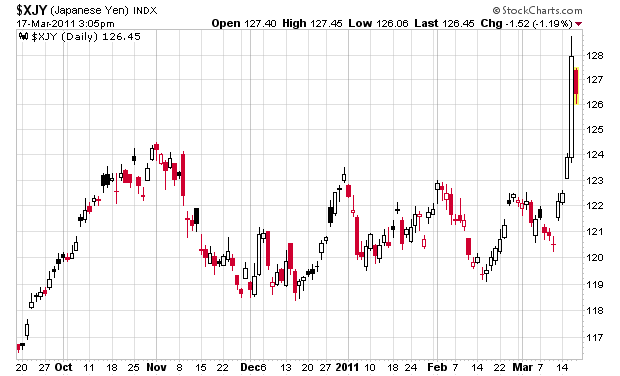Quite a few sites, including Geoff Gannon, have mentioned that Japanese stocks appear to be quite a compelling value at the moment, especially in wake of the damage done by the earthquake. Another site, run by Sivaram Velauthapillai, has a breakdown of stocks that have traded in the past year, and after the earthquake. Larry Macdonald also touches upon the issue of Japanese equities.
In fact, you can simply look at the Japanese Yen currency chart and see that people have been piling into the yen, which would suggest that capital is being moved into the country at a rapid pace:
And when looking at the company in the centre of it all, Tokyo Electric Power Company (JP: 9501), they have been hacked down from about 2100 yen per share to 800 yen today – their traditional range over the past 5 years has been roughly 2000 yen to 4000 yen a share. One would think they are a compelling value without even looking at any financial statements.
I will not be investing in Japan. One of my basic investing rules is not to invest in countries that do not have English as their primary language. I very rarely make exceptions to this. The other reason is that I do not think my vantage point across the Pacific Ocean gives me any better advantage than somebody domestic – Japanese traders are just as active as well as everybody around the planet. It is very difficult, culturally, to tell what the true impact of this disaster will be in terms of domestic sentiment – you can generally only get that impression by being there.
The Japanese government also has severe issues concerning its finance and being able to maintain the standard of living of its citizens. I do not get the impression that investors have sufficiently priced in hidden risks concerning the outcome of this disaster – what if this is earthquake is the trigger to a sovereign debt crisis in Japan? Is a 200%+ debt-to-GDP ratio not low enough to have people a little skittish about giving the government another $500 billion to clean up the mess? Note that 5-year credit default swaps in Japan are now at around 1.25%!
Although looking at charts of utility companies dropping by 2/3rds may seem like there is value, I will be letting this one pass by. I am sure there is huge opportunity, but being able to dig through the necessary information to make rational investment decisions in individual equities in Japan is not something I can do. One might considering investing in an index fund, but investing in index funds is not my style of investing – it will not produce outsized gains. In fact, in the longer run, domestic Japanese consumption could be taking a bigger nose dive than what most people expect.
There is too much unknown risk, which is why I am standing on the sidelines.


